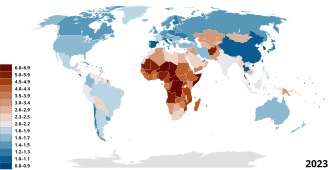
Back معدل الخصوبة الكلي Arabic Сумарны каэфіцыент нараджальнасці Byelorussian Тотален коефициент на плодовитост Bulgarian Taxa de fecunditat Catalan Fertilitetsrate Danish Fertilitätsrate German Fekundindico Esperanto Tasa de fertilidad Spanish Summaarne sündimuskordaja Estonian Ugalkortasun-tasa oso Basque

The Total Fertility Rate (TFR) of a population is the average number of children that are born to a woman over her lifetime if:
- they were to experience the exact current age-specific fertility rates (ASFRs) through their lifetime
- and they were to live from birth until the end of their reproductive life.[1]
It is obtained by summing the single-year age-specific rates at a given time. As of 2023[update], the total fertility rate varied widely across the world, from 0.72 in South Korea[2] to 6.73 in Niger.[3][4]
Fertility tends to be correlated with levels of economic development. Historically, developed countries have significantly lower fertility rates, generally correlated with greater wealth, education, urbanization, and other factors. Conversely, in least developed countries, fertility rates tend to be higher. Families desire children for their labor and as caregivers for their parents in old age. Fertility rates are also higher due to the lack of access to contraceptives, generally lower levels of female education, and lower rates of female employment. It does not significantly correlate with any particular religion.[5]
As of 2020, the total fertility rate for the world is 2.3.[6] The global TFR has declined rapidly since the 1960s, and some forecasters like Sanjeev Sanyal argue that the effective global fertility rate will fall below global replacement rate, estimated to be 2.3, in the 2020s.[7][8] Projections of world human population indicate the transition from long-term growth to long-term decline during the period 2050–2070.[7] The United Nations predicts that global fertility will continue to decline for the remainder of this century and reach a below-replacement level of 1.8 by 2100,[9] and that world population will peak during the period 2084–2088.[10]
- ^ "Definitions and Notes - The World Factbook". www.cia.gov. Archived from the original on 2022-04-18. Retrieved 2023-02-22.
- ^ "South Korea's birth rate has become a national emergency".
- ^ "World Population Prospects - Population Division - United Nations". population.un.org. Archived from the original on 2020-06-04. Retrieved 2023-02-22.
- ^ Cite error: The named reference
:5was invoked but never defined (see the help page). - ^ Rosling, Hans (2019). Factfulness. Sceptre. pp. 89, 176. ISBN 978-1-473-63747-4.
- ^ "Fertility rate, total (births per woman)". The World Bank. Archived from the original on 2019-11-29. Retrieved 2022-02-25.
- ^ a b Sanyal, Sanjeev (30 October 2011). "The End of Population Growth". Project Syndicate. Archived from the original on 8 January 2016. Retrieved 17 October 2012.
- ^ Gietel-Basten, Stuart; Scherbov, Sergei (December 2, 2019). "Is half the world's population really below 'replacement-rate'?". PLOS ONE. 14 (12): e0224985. Bibcode:2019PLoSO..1424985G. doi:10.1371/journal.pone.0224985. PMC 6886770. PMID 31790416.
- ^ Cite error: The named reference
:8was invoked but never defined (see the help page). - ^ "World Population Prospects 2022, Standard Projections, Compact File, Variant tab, Total Population as of 1 January (thousands) column". United Nations Department of Economic and Social Affairs, Population Division. 2022.
© MMXXIII Rich X Search. We shall prevail. All rights reserved. Rich X Search